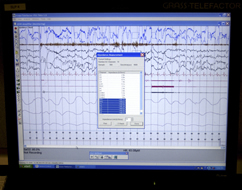UA Seeks ‘Gold Seal’ Accreditation for Human Research
By Chris Bryant

As the University of Alabama positions itself for major growth in its research activities, it is simultaneously launching a multi-year accreditation effort designed to offer the most comprehensive protection available to its human research participants.
UA is voluntarily seeking accreditation from the Association for the Accreditation of Human Research Protection Programs Inc., a Maryland-based organization which seeks to ensure that research organizations adhere to federal and state research requirements and use the highest standards to protect the use of human beings in research activities.
“Obtaining this accreditation demonstrates The University of Alabama’s commitment to our research participants, our own investigators and our community,” said Dr. Marianne Woods, associate vice president for research at UA.
If successful in obtaining accreditation status, UA would join Vanderbilt, the University of Louisville, the University of Arkansas for Medical Sciences, and East Tennessee State University, as the only Southeastern universities obtaining the signification.
The accreditation process, which takes a minimum of two years, will include self-assessment, peer review and education, said Dr. Sharol Jacobson, professor emeritus and former director of research in UA’s Capstone College of Nursing and a leader of UA’s accreditation effort.
“We need research,” Jacobson said of society. “It’s valuable, and people do not need to be afraid to participate in it. We are committed to our research participants that they have a positive experience.”
The accrediting agency will evaluate UA according to established standards in four areas it refers to as domains, Jacobson said. Specific standards are lengthy and detailed, but examples include establishing a formal process to monitor and continually improve the protection of human research participants, educating investigators and staff about their ethical responsibilities to participants, ensuring the independence of a board, such as the Institutional Review Board, in its oversight functions, certifying research investigators meet requirements, assuring human research protection requirements are addressed with research sponsors, and demonstrating an effective means of communicating with the community about concerns.
“It really is the right thing to do,” Jacobson said of the accreditation process, particularly as UA’s research ventures grows. “When I came here in 2000, there was very little clinical research, and clinical trials were new,” Jacobson said. Those efforts, as well as UA’s overall focus on research, are growing, she said. The increased activity brings increased responsibility.
“It should be much harder to commit scientific misconduct, and it not be detected,” Jacobson said of reaching accreditation status.
By year’s end, UA expects to have approved more than 450 human subject research projects, said Carpantato Myles, research compliance officer. That would be an increase of approximately 30 percent over 2005, which, itself, saw a 20 percent increase over 2004.

“In the next decade or so, everyone will have to be certified or accredited,” said Dr. John C. Higginbotham, chair of the UA Medical Institutional Review Board and associate dean for research and health policy in the College of Community Health Sciences. “I think The University of Alabama wants to be ahead of that, and so we’re moving in that direction already. We must be ever vigilant in protecting the rights of those we seek to work with in our research,” Higginbotham said.
In addition to those referenced above, others working closely with the external accreditation committee will be John Dew, director of the office for continuous quality improvement; John Stem, director of the research and consulting lab in the Institute for Social Science Research and vice-chair of UA’s Non-Medical Institutional Review Board; Michael Spearing, office of counsel, and Bishop Earnest Palmer, a community representative.
The process will include campus visits by the accrediting agency, who will meet not only with UA’s Institutional Review Boards and others directly involved in the process, but also random faculty and community members, Jacobson said.
“This process is, in many ways, similar to the accreditation process that the University goes through with SACS (Southern Association of Colleges and Schools),” Jacobson said. “Once you get accreditation, you have to keep it. It commits us to continuous action and evaluation and certain quality improvements. “It’s a commitment to our research enterprise.”
According to the accrediting agency’s Web site, achieving this accreditation “signifies that organizations are committed to the most comprehensive protections for research participants and the highest quality research.”
UA, a student-centered research university, is seeking to transform itself into one of the top 50 research institutions in the United States. In fiscal 2005, UA’s sponsored project expenditures were approximately $75 million, up some $20 million since 1999. Of that $75 million, which includes grants and contracts related to teaching, public service, research, construction, fellowships and scholarships, $28.9 million is in sponsored research expenditures, a $5.4 million increase since 1999.
Further Reading